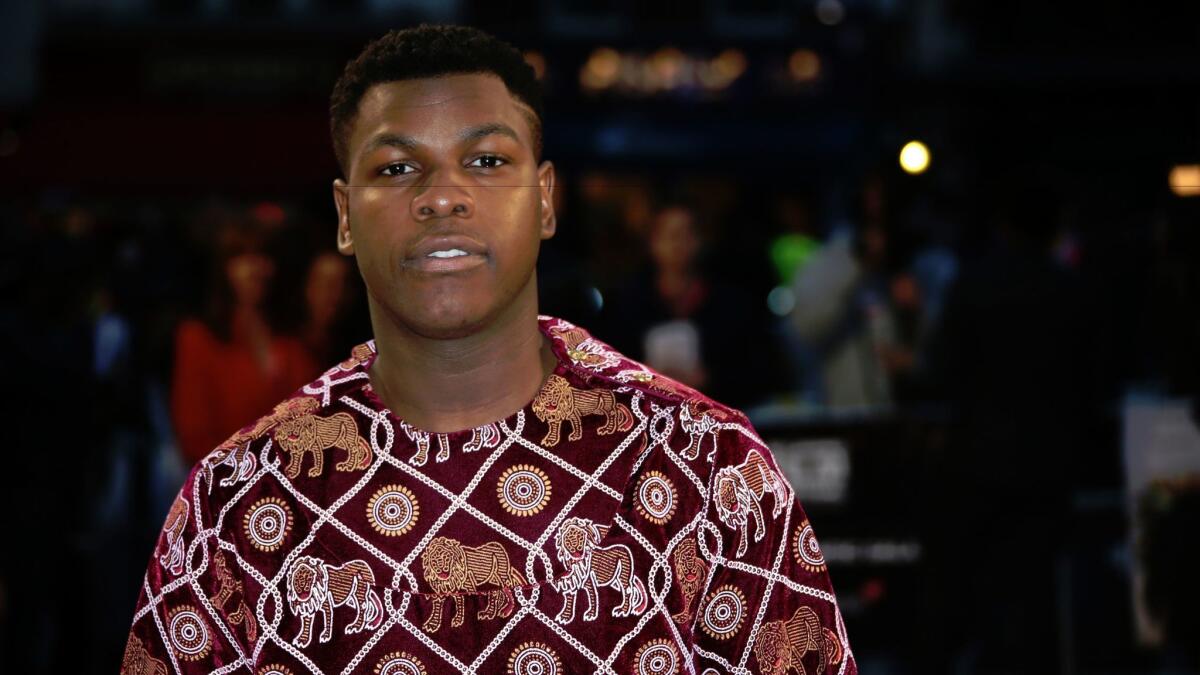What having more foreign members in the academy means in the aftermath of #OscarsSoWhite
Like most people, German filmmaker Maren Ade isn’t generally in the habit of checking her spam email folder. But one day in early July she happened to take a look and was surprised at what she found there.
Sitting in Ade’s junk inbox was an invitation from the Academy of Motion Picture Arts and Sciences to become one of its newest members.
“Maybe I should check my spam account more often,” joked Ade, 39, whose upcoming comedy “Toni Erdmann” is Germany’s Oscar submission this year for foreign-language film. “Sometimes there are interesting things there.”
Ade was one of 283 new international members representing 59 countries who were invited this year to join the academy in a concerted push to further diversify and globalize the nearly 90-year-old institution. That push, which accelerates an ongoing effort over the past decade to internationalize Hollywood’s preeminent film organization, has the potential to reshape not only what the academy looks like, but perhaps how it votes as well.
Members would say, ‘I can’t believe Agnès Varda is not a member yet!’ ‘Why isn’t Wong Kar-wai in?’ ‘Why aren’t the Dardenne brothers in?’
— Academy CEO Dawn Hudson
In the near term, the academy’s increased foreign outreach is creating logistical complications for awards consultants who mount Oscar campaigns, as they scramble to figure out how to reach far-flung new members who speak a wide variety of languages and may live thousands of miles from the nearest official academy screening.
In the longer term, some believe this large influx of foreign members could lead to a shift over time in the kinds of films and performances that receive nominations, boosting diversity and lending the Oscars a more international, art-house flavor.
In a dramatic step aimed at transforming the historically overwhelmingly white and male institution in response to the #OscarsSoWhite uproar that erupted in January – in which, for the second year in a row, no actors of color received nominations – the academy invited 683 industry professionals into its ranks in July, by far the largest and most diverse class ever.
With the academy aiming to double the number of women and minorities in its ranks by 2020, 46% of the new invitees were female and 41% were people of color – and more than 40% were from outside the United States.
For the academy’s leadership, spearheaded by President Cheryl Boone Isaacs and CEO Dawn Hudson, the influx of international members – which include both familiar names like British actor John Boyega (“Star Wars: The Force Awakens”) and Danish director Nicolas Winding Refn (“Drive”) and many others who may be largely unknown outside the film-festival circuit – represents the fruits of an initiative that had been in the works even before the issue of diversity came to the fore.

“Internally, we’ve always thought of ourselves as an international organization representing the global film community,” Hudson said. “But what we realized is the global community doesn’t always think of the academy that way or know how to connect to us. So over the last several years we’ve been laying in the foundation for reaching those members, letting them know we want the most talented filmmakers from around the world as part of our community.”
While some of this year’s new foreign invitees, like Swedish actress Alicia Vikander and Spanish director J.A. Bayona, are already well known in Hollywood, for others, being invited into the academy has the potential to open doors and change industry perceptions.
Saudi filmmaker Haifaa Mansour says that, as her country’s first female director, being invited this year into Hollywood’s most exclusive club is a career game-changer. The 42-year-old director, whose 2012 debut feature, “Wadjda,” was the first film to be shot entirely in Saudi Arabia, recently finished her first English-language film, “A Storm in the Stars.”
“Sometimes as a woman, and especially one from a foreign country, it gets hard for them to find a project that fits you as a director,” said Mansour. “[The academy] is the most prestigious organization in the world. It anchors you in. It makes me more relevant. People actually take you seriously.”
From a sheer logistical standpoint for those tasked with mounting Oscar campaigns, simply reaching hundreds of new members who are scattered across the world could complicate matters.
My worry is: How do they see the movies? Do they speak English? Will screeners work? It makes it more challenging … which I love.
— Awards consultant Cynthia Swartz
“My worry is: How do they see the movies?” said awards consultant Cynthia Swartz, who has helped steer numerous Oscar campaigns over the years. “In theaters? Screenings? Do they speak English? Will screeners work? It makes it more challenging … which I love. I’m desperate to be challenged.”
In many ways, the academy’s foreign outreach simply reflects the ever-increasing internationalization of the film industry as a whole. Well over half of Hollywood’s box-office revenue now comes from abroad, and the academy, which recently renewed its deal with ABC for the broadcast rights to the annual Oscar telecast through 2028, is eager to capture as much of that global moviegoing audience as possible.
In each of the academy’s branches, extra effort has been made over the past several years to identify and recruit potential new members from abroad, including in some cases highly respected actors, writers, directors and others who had been previously overlooked.
“People hadn’t kind of looked in their own branches and they were shocked when they took a hard look,” Hudson said. “Members would say, ‘I can’t believe Agnès Varda is not a member yet!’ ‘Why isn’t Wong Kar-wai in?’ ‘Why aren’t the Dardenne brothers in? They’re winning at Cannes right now!’ ”
But while the academy had been taking incremental steps to broaden its membership both domestically and internationally for years, Hudson says that effort took on a heightened urgency this year in the wake of the #OscarsSoWhite controversy.
“We said, ‘Wait a minute — we have not caught up with our mission. We aren’t moving fast enough for that goal,’ ” Hudson said. “What you saw this year is, ‘OK, all hands on deck, we really need to make some bold changes to signal this is our intention. This is not a toe in the water.’ ”
The fact is, for the academy to meet its ambitious diversity targets simply by adding members from the States would have been extremely difficult, if not impossible, given persistent underlying inequities in hiring in the industry. In the next three years, The Times estimates the academy will have to invite 85 people of color and 395 women to its ranks per year to reach its publicly stated goals.
In the wake of the #OscarsSoWhite firestorm, many will be closely scrutinizing this year’s nominations to glean any sign of an immediate effect from the academy’s diversity efforts. That this awards season includes several high-profile films that deal head-on with issues of race – including the dramas “Moonlight,” “Loving” and “Fences” – makes a replay of the controversy this year unlikely, according to most Oscar prognosticators.
Over time, however, it remains to be seen whether the academy’s increasingly diverse – and increasingly global – membership will be reflected in future Oscar nominations.
While foreign-language movies have their own award at the Oscars (this year, a record 85 films were submitted for consideration), they have often been recognized by academy voters in other major categories as well. The French-language drama “Amour” earned nominations for directing, acting, screenplay and picture in 2012, for example.
Some believe the increase in the proportion of international members will further boost the odds of making that leap.
“I think the more international members that are brought in, the more you’re going to see these nominations for foreign-language films,” said Michael Barker, co-president of Sony Pictures Classics. “They’re going to be considering these movies in all areas, not just the foreign-language category.”
Swartz believes the directors race in particular could change “dramatically,” given the number of new international members admitted this year into a branch that’s one of the academy’s smaller, more exclusive groups. “That’s where you could see some real impact from this year’s class,” Swartz said.
But for many, it’s far from clear that the academy’s shifting membership will have a significant impact on Oscar nominations going forward. Some speculate that members from other countries may actually be less receptive to films dealing with the African American experience, which tend not to perform strongly at the box office overseas. Others point out that men and women from various different cultures will not necessarily share the same tastes — and that, in fact, the kinds of films that most reliably unite filmgoers around the world are big-budget superhero films and franchises like “Star Wars,” not art-house fare.
“New members from 59 separate countries aren’t going to join hands and vote diversity necessarily,” said longtime Oscar consultant Tony Angellotti, whose Angellotti Co. has represented scores of awards contenders. “Some of our commercial successes work very well in those countries, and some smaller films or more diverse films likely aren’t going to register on a personal experience level with members who do not have uniquely American life experiences.”
Ade said she is curious to see how things unfold. “When you look at all these names, there’s a real art-house sensibility to this new class. Will they have a different sensibility? Maybe.”
She said with a laugh: “I know I have a different sensibility.”
Twitter: @joshrottenberg
Twitter: @glennwhipp
ALSO:
Five documentaries to watch for this Oscar season
Are early film releases hampered or helped come Oscar season?
Oscars 2016 preview: Waiting for the day when inclusion is no longer news
More to Read
Only good movies
Get the Indie Focus newsletter, Mark Olsen's weekly guide to the world of cinema.
You may occasionally receive promotional content from the Los Angeles Times.












